Table of Contents
I have had several clients ask me whether pushups and planks are good for osteoporosis, and if there are situations where they might be harmful. I will address these questions in this post.
Later I will describe several plank exercises that you can incorporate into your exercise routine that are both safe and effective if you have osteoporosis, osteopenia or low bone density.
Should You Do Planks and Pushups if You Have Osteoporosis?
Judy (not her real name) recently contacted me with a question regarding her exercise program. Like many people, Judy is doing everything she can to build the strength of her body and bones but she is receiving conflicting, confusing and incomplete messages from people she consults.
Here are Judy’s questions:
Is it okay to do pushups and planks without risk [of a vertebral compression fracture] to the spine?
The muscles in my upper body need to be built up. I had been working on pushups and planks with my trainer until my doctor recently did an X-ray of my back and discovered two vertebral fractures in the middle of my spine. He told me to stop doing pushups and planks.
I can’t understand why pushups would be bad since the spine seems to stay in a neutral position.
I’ve tried to research this issue on the internet but can’t find anything for or against pushups and planks for those with osteoporosis. Do you believe pushups and planks are good for osteoporosis? Are they helpful or risky?
Are Pushups and Planks Good for Osteoporosis?
When done with proper form, both the pushup and plank are excellent exercises for people with osteoporosis. I will briefly discuss each exercise type.
Pushups for Osteoporosis
The pushup is in the Exercise for Better Bones program. In fact, I have several variations of the pushup — each one targeted at a specific program level.
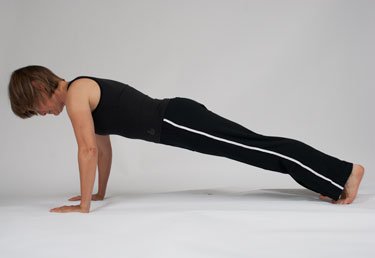
The key things to keep in mind with regard to pushups are:
- Progress slowly and build up your strength. This is why I offer several variations starting with the wall pushup all the way to the pushup with a twist.
- Focus on form and make sure you maintain postural alignment (explained more detail below.)
- Counter balance your pushup with exercises that strengthen the back.
- Make sure you work on flexibility, otherwise you risk compromising your posture.
In Exercise for Better Bones, I provide very specific guidance on how to maintain form. Make sure you watch the video that accompanies the exercise in the program.
I think the big concern your doctor may have is that both exercises strengthen the pectorals (chest muscles). Unless you counter balance them with back strengthening exercises (such as the Floor M) and ensure that you keep the muscles flexible (doorway stretch and elbow press, under Postural Exercises) that the process of strengthening the pectorals muscles can promote a more rounded kyphotic posture.
A kyphotic posture can lead to further stresses on the vertebrae and could cause vertebral compression fractures.
I would ensure you emphasize your back exercises in your routine. Do them when you are feeling fresh and energetic and make them a priority in your workout.
Planks for Osteoporosis
The plank exercise can be very effective for people with osteoporosis for several reasons.
- The foundation of movement (and exercise) is good posture. A strong core contributes to a good posture and a good posture reduces your risk of a spinal compression fracture.
- The increased strength from a strong core reduces your risk of a fall (because you have the strength to catch yourself if you lose your balance.)
My book Strengthen Your Core and my online course, Building a Stronger Core, provide clear instructions on how to safely increase your core strength through the plank and side plank. I provide several examples of each type of plank below in this post.
Exercise Recommendations for Osteoporosis
Exercise is an essential ingredient to bone health. If you have osteoporosis, therapeutic exercise needs to be part of your osteoporosis treatment program.
But what exercises should you do and which ones should you avoid? What exercises build bone and which ones reduce your chance of a fracture? Is Yoga good for your bones? Who should you trust when it comes to exercises for osteoporosis?
A great resource on exercise and osteoporosis is my free, seven day email course called Exercise Recommendations for Osteoporosis. After you provide your email address, you will receive seven consecutive online educational videos on bone health — one lesson each day. You can look at the videos at anytime and as often as you like.

I cover important topics related to osteoporosis exercise including:
- Can exercise reverse osteoporosis?
- Stop the stoop — how to avoid kyphosis and rounded shoulders.
- Key components of an osteoporosis exercise program.
- Key principles of bone building.
- Exercises you should avoid if you have osteoporosis.
- Yoga and osteoporosis — should you practice yoga if you have osteoporosis?
- Core strength and osteoporosis — why is core strength important if you have osteoporosis?
Enter your email address and I will start you on this free course. I do not SPAM or share your email address (or any information) with third parties. You can unsubscribe from my mail list at any time.
How to Do the Plank Exercise
The plank exercise is a great core exercise. When done correctly, it can improve posture, enhance performance and strengthen you from your head to your toes.
However, when done incorrectly it can encourage poor postural alignment such as a kyphotic posture. This posture is not good for your breathing or your spine and is of especial concern for people with osteoporosis, osteopenia and low bone density.
Plank Exercise: Strengthen Your Core
My book Strengthen Your Core covers the theory behind core strength and provides detailed descriptions of different planks and side planks. It is important that you do the plank with good alignment, good form, and good posture.

How to Do the Plank Exercise
In the video, I show how to adjust your plank that supports your alignment and posture.
I am going to discuss the importance of doing planks with good alignment, good form, good posture — whatever wording you want to use.
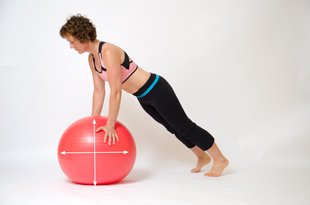
Plank Exercise Done Incorrectly
Here is a demonstration of planks that I often see clients come in with, and they’ve either been doing these in their yoga class, Pilates class, part of an exercise routine.
The plank is often done in a way that they’re just trying all they can.
They lock out the elbows.
They’re on their hands and on their toes. This is a very unsafe plank, especially if you have low bone density or osteoporosis because of the flexion loads.
Plank Exercise Done Correctly
Ideally, you want to bring your plank in a position that supports your alignment and supports your posture.
- This might mean that you don’t start on your hands and your toes.
- It may mean that you start your plank at a higher position so that you can then support all of the musculature of the shoulder, of the hips, of the ankles, of your spinal alignment.
Ultimately, you want to be strong with nice alignment.
If you do your plank in the first position that I showed you, you’re going to be supporting an alignment that’s kyphotic. That posture is not helpful on your breath, on your spine or anything else. You should work on good postural alignment and getting the most out of your planks.
How To Do a Side Plank
Side plank exercises are a great way to build core strength and increase stability. I will cover two side plank exercises, the beginner level and then the active level. Both of these can be found in my book, Strengthen Your Core.
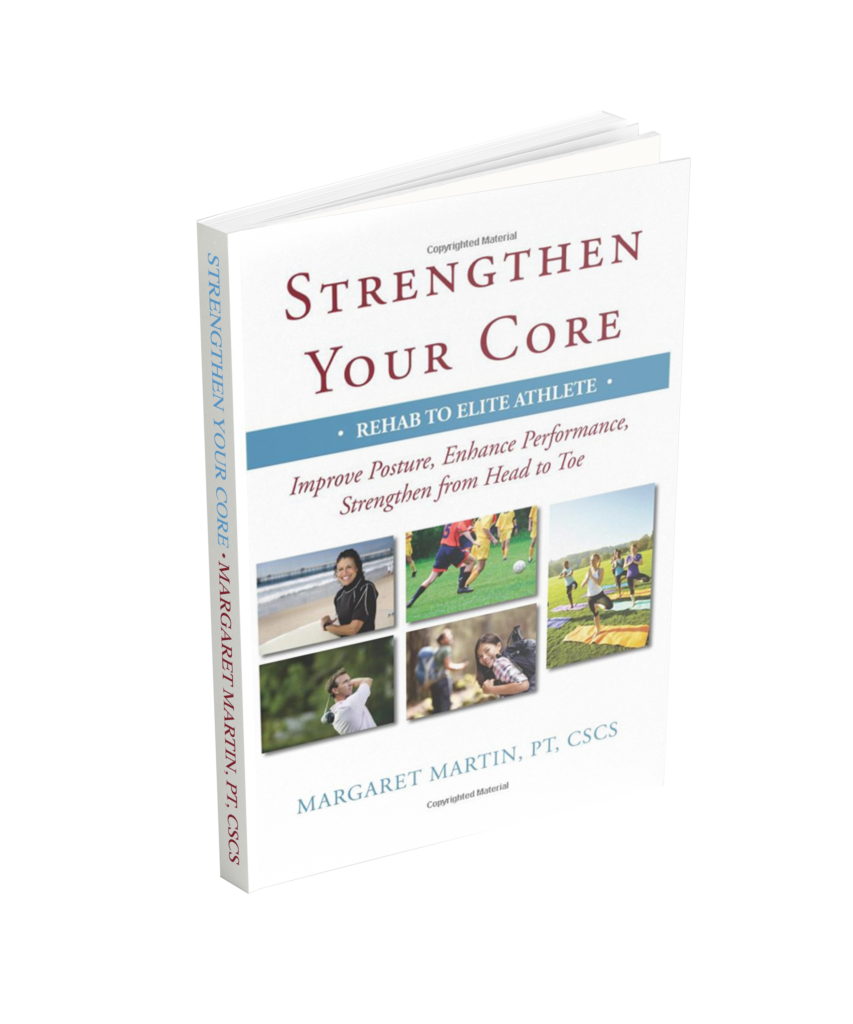
Beginner Side Plank Exercise
In this video I demonstrate the Side Plank Exercise Roll core exercise for beginners from the Strengthen Your Core exercise program.
During the Roll, you transition as a block, with perfect form, between the Plank exercise and Side Plank exercise. This one of a number of core strengthening exercises for beginners in Strengthen Your Core.
Core Exercise for Beginner Tips: Shoulder Support
For many individuals, weight bearing through one shoulder is quite a challenge. Here are a few tips to add shoulder support:
- In the side plank from the chair, you can add support on the shoulder with the upper arm.
- You can also take weight, if that shoulder is your limiting factor, through this bottom arm.
Those are things that can help you start to build strength through the shoulder and not feel defeated because the amount of pressure that you’re experiencing through the shoulder.
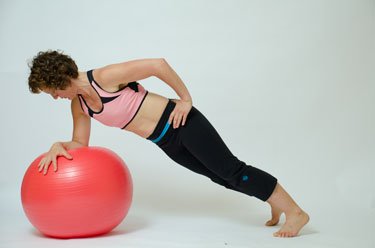
Core Exercise for Beginner Tips: Arm Support
With the planks and especially with the side planks, as opposed to just resting on the chair, I want you to press into the chair.
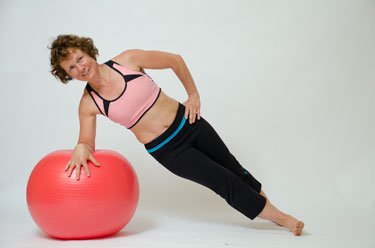
- To provide additional support, place a folded yoga mat under the arm so that it feels more cushioned through the forearm.
- Draw the shoulder blade down while pressing into the chair.
- If I just let the chair support me, this is what’s going to happen. I hang on with my ligament and that’s not going to be comfortable or beneficial.
- Press into the chair, drop the shoulder blade down and then align your head with the rest of your body. This is an important component of the beginner’s side plank 90.
- When we take the side plank into a 45 we can take a break and reset and then position our body at a 45, position the leg at a 45 and then drop the body and again think of it drawing the shoulder blades down and back.
- Your hand can stay at the chair if you want a little additional support through the supporting shoulder or it can come by your side.
- It can rest on the shoulder that’s supporting you, but again your whole body should maintain that neutral position.
Side Plank Roll Core Exercise for Beginners
Now let’s do the side plank roll core exercise for beginners. To demonstrate this, I will turn away from you and take the roll onto the chair.
- Based on my body size, this chair is just a little bit tall for me.
- Press to stay drawn down.
- My ideal chair height would probably be about 16 inches to do the roll from my knee and this is about 17 inches.
- In this position press firmly down and hold each position for five seconds.
- Roll and keep everything tight.
- Now go into a full plank from your knees.
- Roll into the 45 degree side plank.
- Draw your shoulder blades down and back and right into complete the beginner.
Active Side Plank Exercise
In this video I show several variations of how to do side plank exercise for the Active level in the Strengthen Your Core exercise program.
I demonstrate the side plank exercise at both a 90 and 45 degree angle. I also show how to modify your lift or change the duration of your lift.
How to Do Side Plank Exercise
Let me start with the 90 degrees because that allows me to keep talking to you straight on with the camera.
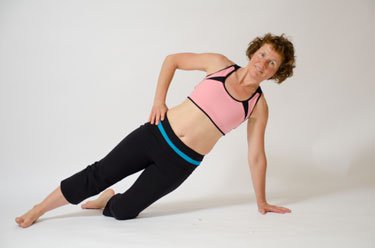
- Make sure your elbow is tucked in slightly from the shoulder.
- It’s going to feel a little bit awkward because it is going to feel like it’s a little bit tight in, but that’s going to allow you to have your humerus straight in a vertical position once you lift up.
- As you drop back, the elbow is in a little bit closer to the body, but as you lift up it’s sitting just directly underneath, and that’s going to be the most comfortable for the shoulder joint.
- In Strengthen Your Core, it shows the thigh being straight in line with the body, but if you attempt this and you’re going, “Well, that intensity is a little higher than I hoped for”, but you don’t feel like going back to the active level four, you can bring your bottom knee forward slightly, 20 or 30 degrees.
- By doing so, that’s going to reduce the intensity of this side plank.
- The other thing you can play with is the distance that your hip is lifted off from the ground.
- Lift off just a little bit is going to be less intense than if you lift off and create that straight line into the side plank.
Variation: How to Do Side Plank Exercise
Another variation that you can do, as opposed to holding the plank for the entire 20 seconds, is to lift and lower during that time.
- You want press into the floor.
- Press into the floor and engage all of the muscles around the shoulders to support you.
- If you’re going to come up, you can take this hand to give yourself a little more support at the shoulder, if that’s helpful.
- Your head is in a neutral position.
- If that’s feeling too intense, just drop down and pull back up again, and drop down and pull back up, which allows you a variation within the active level side plank, 90 degrees.
- We can take the same concepts into the 45.
- Either your leg is going to be straight with your body when you turn onto a 45 degree, or you are going to allow yourself to have a little bit more flexion at the hip.
- This little bit more flexion is going to make the intensity much less for the abdominal wall.
- Here’s the 45.
- Press in and engage the musculature around the shoulder girdle.
- If you need more support, bring it up through here.
This gives you some ideas for positioning yourself and modifying the side planks, both the 90 and 45, to work best for you.
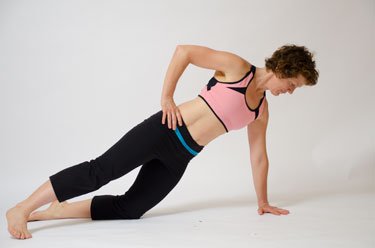
Dynamic Plank Exercise
The Dynamic Plank Exercise Roll for Active Level from the Strengthen Your Core program requires that you do both the Plank and Side Plank exercises in perfect form as you transition between the poses.
I have seen many clients who struggle to do this exercise well. Often they focus on trying to get the side plank “working” and as they progress through the roll, they lose control and start to lose form (and with that, the effectiveness of the exercise).
I work with them closely as they progress from one stage of the roll to the next and coach them along the way so that they maintain good form and get as much benefit as possible from the side plan exercise roll. Of course, once they successfully execute the roll, I give them a big pat on the back!
In this video I demonstrate the dynamic plank exercise roll so that you can follow along and execute it flawlessly. Be patient and take the time you need to build up to this. And once you are there, contact me and I will give you your pat on the back.
Dynamic Plank Exercise Roll
Let’s go through the active level dynamic plank exercise roll step by step. We will go from the side plank 90, to the side plank 45, to the full plank and finally over onto the opposite side.

Dynamic Plank Exercise Roll
- Tuck your elbow in slightly.
- Lift yourself up.
- Hold for five seconds.
- Take it over to the 45.
- Five, four, three, two, one.
- The objective here is that throughout the dynamic plank exercise, I endeavour not to move anything between my knees and my head.
- I keep everything else, as I’m rolling everything staying as stable as possible.
- The dynamic plank exercise roll is something that you want to do as an additional challenge.
- Once you’ve gone through your maximum holds for your 90 degree planks and 90 degree side planks.
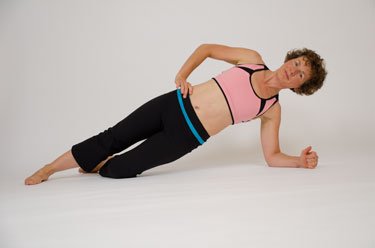
Push Ups Variations
If you want to learn how to do push ups properly, visit Push Ups Variations.
Core Exercises Guide
Want to learn more about core exercises? Visit my Core Exercises Guide.

Comments